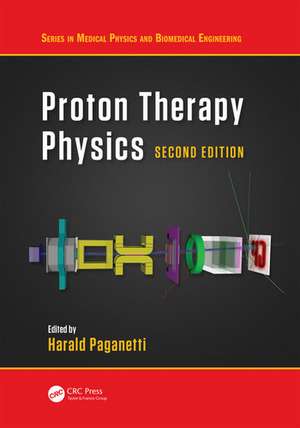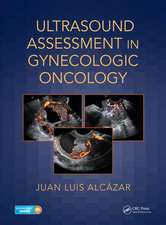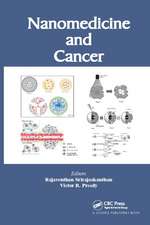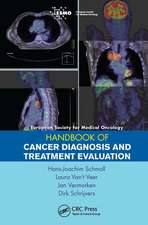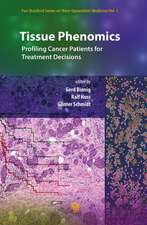Proton Therapy Physics, Second Edition: Series in Medical Physics and Biomedical Engineering
Editat de Harald Paganettien Limba Engleză Hardback – 13 noi 2018
After tracing the history of proton therapy, the book explores the atomic and nuclear physics background necessary for understanding proton interactions with tissue. The text then covers dosimetry, including beam delivery, shielding aspects, computer simulations, detector systems and measuring techniques for reference dosimetry. Important for daily operations, acceptance testing, commissioning, quality assurance and monitor unit calibrations are outlined. The book moves on to discussions of treatment planning for single- and multiple-field uniform doses, dose calculation concepts and algorithms, and precision and uncertainties for nonmoving and moving targets. Imaging for treatment guidance as well as treatment monitoring is outlined. Finally, the biological implications of using protons from a physics perspective are discussed.
This book is an ideal practical guide for physicians, dosimetrists, radiation therapists, and physicists who already have some experience in radiation oncology. It is also an invaluable reference for graduate students in medical physics programs, physicians in their last year of medical school or residency, and those considering a career in medical physics.
Features:
- Updated with the latest technologies and methods in the field, covering all delivery methods of proton therapy, including beam scanning and passive scattering
- Discusses clinical aspects, such as treatment planning and quality assurance
- Offers insight on the past, present, and future of proton therapy from a physics perspective
| Toate formatele și edițiile | Preț | Express |
|---|---|---|
| Paperback (1) | 339.86 lei 3-5 săpt. | +71.36 lei 4-10 zile |
| CRC Press – 30 iun 2020 | 339.86 lei 3-5 săpt. | +71.36 lei 4-10 zile |
| Hardback (1) | 840.89 lei 6-8 săpt. | |
| CRC Press – 13 noi 2018 | 840.89 lei 6-8 săpt. |
Din seria Series in Medical Physics and Biomedical Engineering
-
 Preț: 362.42 lei
Preț: 362.42 lei - 5%
 Preț: 1304.46 lei
Preț: 1304.46 lei - 5%
 Preț: 346.24 lei
Preț: 346.24 lei - 15%
 Preț: 673.74 lei
Preț: 673.74 lei - 5%
 Preț: 339.69 lei
Preț: 339.69 lei -
 Preț: 356.64 lei
Preț: 356.64 lei -
 Preț: 359.37 lei
Preț: 359.37 lei -
 Preț: 364.30 lei
Preț: 364.30 lei -
 Preț: 366.36 lei
Preț: 366.36 lei - 9%
 Preț: 632.16 lei
Preț: 632.16 lei -
 Preț: 368.77 lei
Preț: 368.77 lei -
 Preț: 373.96 lei
Preț: 373.96 lei -
 Preț: 339.86 lei
Preț: 339.86 lei - 46%
 Preț: 352.95 lei
Preț: 352.95 lei - 23%
 Preț: 371.45 lei
Preț: 371.45 lei - 25%
 Preț: 1057.26 lei
Preț: 1057.26 lei - 5%
 Preț: 546.82 lei
Preț: 546.82 lei - 26%
 Preț: 1098.62 lei
Preț: 1098.62 lei - 49%
 Preț: 680.73 lei
Preț: 680.73 lei - 18%
 Preț: 1064.36 lei
Preț: 1064.36 lei - 22%
 Preț: 325.85 lei
Preț: 325.85 lei - 5%
 Preț: 914.71 lei
Preț: 914.71 lei - 23%
 Preț: 377.01 lei
Preț: 377.01 lei - 30%
 Preț: 848.15 lei
Preț: 848.15 lei - 15%
 Preț: 489.26 lei
Preț: 489.26 lei - 18%
 Preț: 1068.15 lei
Preț: 1068.15 lei - 28%
 Preț: 603.31 lei
Preț: 603.31 lei - 26%
 Preț: 1042.56 lei
Preț: 1042.56 lei - 25%
 Preț: 851.88 lei
Preț: 851.88 lei - 5%
 Preț: 910.15 lei
Preț: 910.15 lei - 15%
 Preț: 461.03 lei
Preț: 461.03 lei - 5%
 Preț: 915.27 lei
Preț: 915.27 lei - 18%
 Preț: 1438.46 lei
Preț: 1438.46 lei - 28%
 Preț: 1046.99 lei
Preț: 1046.99 lei - 5%
 Preț: 1038.35 lei
Preț: 1038.35 lei - 14%
 Preț: 312.45 lei
Preț: 312.45 lei - 5%
 Preț: 747.83 lei
Preț: 747.83 lei - 27%
 Preț: 1228.34 lei
Preț: 1228.34 lei - 18%
 Preț: 1059.45 lei
Preț: 1059.45 lei - 15%
 Preț: 682.83 lei
Preț: 682.83 lei - 25%
 Preț: 1195.93 lei
Preț: 1195.93 lei - 18%
 Preț: 887.88 lei
Preț: 887.88 lei
Preț: 840.89 lei
Preț vechi: 1115.11 lei
-25% Nou
Puncte Express: 1261
Preț estimativ în valută:
160.95€ • 174.89$ • 135.29£
160.95€ • 174.89$ • 135.29£
Carte tipărită la comandă
Livrare economică 22 aprilie-06 mai
Preluare comenzi: 021 569.72.76
Specificații
ISBN-13: 9781138626508
ISBN-10: 1138626503
Pagini: 772
Ilustrații: 16 Tables, black and white; 282 Illustrations, black and white
Dimensiuni: 178 x 254 x 52 mm
Greutate: 1.62 kg
Ediția:2 ed
Editura: CRC Press
Colecția CRC Press
Seria Series in Medical Physics and Biomedical Engineering
ISBN-10: 1138626503
Pagini: 772
Ilustrații: 16 Tables, black and white; 282 Illustrations, black and white
Dimensiuni: 178 x 254 x 52 mm
Greutate: 1.62 kg
Ediția:2 ed
Editura: CRC Press
Colecția CRC Press
Seria Series in Medical Physics and Biomedical Engineering
Public țintă
Professional Practice & DevelopmentCuprins
1. Proton Therapy: History and Rational 2. Physics of Proton Interactions in Matter 3. Proton Accelerators 4. Characteristics of Clinical Proton Beams 5. Beam Delivery Using Passive Scattering 6. Particle Beam Scanning 7. Secondary Radiation Production and Shielding at Proton Therapy Facilities 8. Monte Carlo Simulations 9. Detectors and Relative Dosimetry 10. Reference Dosimetry and Primary Standards 11. Acceptance Testing and Commissioninn 12. Quality Assurance 13. Monitor Unit Calibration 14. Dose Calculation Algorithms 15. Physics of Treatment Planning for Single-Field Uniform Dose 16. Physics of Treatment Planning Using Scanned Beams 17. Precision and Uncertainties in Planning and Delivery 18. Precision and uncertainties for moving targets 19. Treatment-Planning Optimization 20. Proton Image Guidance 21. In Vivo Dose Verification 22. The Physics of Proton Biology 23. Fully Exploiting the Benefits of Protons: Using Risk Models for Normal Tissue Complications in Treatment Optimization
Notă biografică
Harald Paganetti received his PhD in nuclear physics from the Rheinische-Friedrich-Wilhelms University in Bonn, Germany in 1992. He subsequently entered the field of medical physics and later joined the physics team at Massachusetts General Hospital in 1998. He is currently the Director of Physics Research for Radiation Oncology at Massachusetts General Hospital and a Professor of Radiation Oncology at Harvard Medical School. He has authored and co-authored more than 200 peer-reviewed publications and has edited two books on Proton Therapy.
He has made significant contributions to the field of radiation oncology physics, many of which have found their way into clinical practice. Particularly, he is a pioneer in advanced Monte Carlo dose calculations for proton therapy treatment planning, which allowed the reduction of treatment planning margins for many patients, and in four-dimensional dose calculation aiming at a better understanding of motion effects when using radiation therapy for moving targets. He is considered the world expert on the relative biological effectiveness of proton beams and has had a significant impact in biological effect modeling. In 2014 he received the Excellence in Mentoring Award from Harvard Medical School recognizing his teaching and mentoring activities for junior faculty and students. He serves on various committees mainly for the American Association of Physicists in Medicine (AAPM), for which he was named Fellow in 2014, and American Society for Therapeutic Radiology and Oncology (ASTRO). He is also a member of the National Council on Radiation Protection and Measurements (NCRP).
He has made significant contributions to the field of radiation oncology physics, many of which have found their way into clinical practice. Particularly, he is a pioneer in advanced Monte Carlo dose calculations for proton therapy treatment planning, which allowed the reduction of treatment planning margins for many patients, and in four-dimensional dose calculation aiming at a better understanding of motion effects when using radiation therapy for moving targets. He is considered the world expert on the relative biological effectiveness of proton beams and has had a significant impact in biological effect modeling. In 2014 he received the Excellence in Mentoring Award from Harvard Medical School recognizing his teaching and mentoring activities for junior faculty and students. He serves on various committees mainly for the American Association of Physicists in Medicine (AAPM), for which he was named Fellow in 2014, and American Society for Therapeutic Radiology and Oncology (ASTRO). He is also a member of the National Council on Radiation Protection and Measurements (NCRP).
Recenzii
"This textbook gives an excellent and comprehensive overview on proton therapy physics and is of value for a variety of different readers. Extending and updating the previous edition has improved the book and kept it timely. While it cannot be complete, it covers the most important aspects and provides plenty of references for further reading. The book will be of great value for beginners as well as for experts in the field of proton therapy and should not be missing in the medical physicist’s book shelf!"
—Prof Christian Karger in Physica Medica (69, 2020, 183)
"Proton Therapy Physics should be a must-have reference book on desks of all research and clinical physicists working in the field of proton therapy. The book is very comprehensive, covering all important aspects of proton therapy physics, including beam delivery, dosimetry, operation, treatment planning, image guidance, and biological efforts. Almost all chapter authors are well known experts in the field. So the chapters are all well written, informative, and up-to-date. More importantly, the editor, Dr. Harald Paganetti is a well-respected, well established researcher in proton therapy physics. I would strongly recommend this book!"
— Steve B. Jiang, Professor Vice Chair, University of Texas Southwestern Medical Center
"Proton Therapy Physics is a comprehensive collection of outstanding chapters on the subject matter. The second edition is a necessary and welcome update of the first edition in this rapidly evolving field. It is edited by Prof. Harald Paganetti, an internationally renowned expert in the physics of proton therapy. It is difficult imagine a more qualified individual than Dr. Paganetti, with his in-depth understanding of physics and biology of protons, to produce such an impressive book. In addition to writing or contributing to four of the chapters himself, he has assembled a team of the well-known experts from all over the world to author the remaining nineteen chapters.
The book covers a full range of topics including physics of interactions of protons with matter, design and characteristics of passively-scattered and scanning proton therapy delivery systems, radiation shielding, relative and absolute dosimetry, commissioning and acceptance testing, dose calculations, design and optimization of treatment plans, imaging for proton range determination, uncertainties in planning and delivery of proton therapy and their management, biological effectiveness of protons, and more. Topics are dealt with in appropriate depth and supplemented with thousands of references for those interested in learning more. The book will serve as an excellent resource for students, trainees, radiation dosimetrists, radiation physicists and radiation oncologists. It will be equally valuable to new entrants in the field and for the experts, both clinical and research, interested in refreshing their knowledge.
The true potential of proton therapy to improve outcomes is yet to be realized. There are significant gaps in our understanding of physical and biological aspects of proton therapy and there are limitations of current techniques and technologies. Current research and technological advances are aimed at overcoming these gaps and limitations. Considering how rapidly the field of proton therapy is changing, I hope Dr. Paganetti and his team of contributors will again produce the next edition in a few years."
— Professor Radhe Mohan, MD Anderson Cancer Center, Houston, Texas
"CRC Press have updated and expanded on the first edition of Proton Therapy Physics edited by Professor Harold Paganetti which was first published in 2012. The successful first edition has been restructured with the addition of a few new chapters. Originally with 20 chapters the second edition comes with 23 chapters. The second edition also sees the return of all the previous contributing experts, with the addition of a few others. With the significant increase in number of proton therapy centres around the world, this second edition comes at a good time to provide an update on this continually developing field… Similar to the first edition, this book is well structured and well written. The illustrations are of a high quality, however they come black and white in the hardback (colour in the ebook version). In my opinion, this book serves as an outstanding reference for the physics of proton beam therapy, not only to medical physicists but also physicians and radiation therapists. With proton therapy soon to be arriving in Australia I highly recommend this text for those interested in the field. I will certainly be utilising this text in the teaching of students in the area of proton therapy."
— Alexandre M. C. Santos, Australasian College of Physical Scientists and Engineers in Medicine, in Physical and Engineering Sciences in Medicine (August 2020).
"This textbook gives an excellent and comprehensive overview on proton therapy physics and is of value for a variety of different readers. Extending and updating the previous edition has improved the book and kept it timely. While it cannot be complete, it covers the most important aspects and provides plenty of references for further reading. The book will be of great value for beginners as well as for experts in the field of proton therapy and should not be missing in the medical physicist’s book shelf!"
—Prof Christian Karger in Physica Medica (69, 2020, 183)
"Proton Therapy Physics should be a must-have reference book on desks of all research and clinical physicists working in the field of proton therapy. The book is very comprehensive, covering all important aspects of proton therapy physics, including beam delivery, dosimetry, operation, treatment planning, image guidance, and biological efforts. Almost all chapter authors are well known experts in the field. So the chapters are all well written, informative, and up-to-date. More importantly, the editor, Dr. Harald Paganetti is a well-respected, well established researcher in proton therapy physics. I would strongly recommend this book!"
— Steve B. Jiang, Professor Vice Chair, University of Texas Southwestern Medical Center
"Proton Therapy Physics is a comprehensive collection of outstanding chapters on the subject matter. The second edition is a necessary and welcome update of the first edition in this rapidly evolving field. It is edited by Prof. Harald Paganetti, an internationally renowned expert in the physics of proton therapy. It is difficult imagine a more qualified individual than Dr. Paganetti, with his in-depth understanding of physics and biology of protons, to produce such an impressive book. In addition to writing or contributing to four of the chapters himself, he has assembled a team of the well-known experts from all over the world to author the remaining nineteen chapters.
The book covers a full range of topics including physics of interactions of protons with matter, design and characteristics of passively-scattered and scanning proton therapy delivery systems, radiation shielding, relative and absolute dosimetry, commissioning and acceptance testing, dose calculations, design and optimization of treatment plans, imaging for proton range determination, uncertainties in planning and delivery of proton therapy and their management, biological effectiveness of protons, and more. Topics are dealt with in appropriate depth and supplemented with thousands of references for those interested in learning more. The book will serve as an excellent resource for students, trainees, radiation dosimetrists, radiation physicists and radiation oncologists. It will be equally valuable to new entrants in the field and for the experts, both clinical and research, interested in refreshing their knowledge.
The true potential of proton therapy to improve outcomes is yet to be realized. There are significant gaps in our understanding of physical and biological aspects of proton therapy and there are limitations of current techniques and technologies. Current research and technological advances are aimed at overcoming these gaps and limitations. Considering how rapidly the field of proton therapy is changing, I hope Dr. Paganetti and his team of contributors will again produce the next edition in a few years."
— Professor Radhe Mohan, MD Anderson Cancer Center, Houston, Texas
"CRC Press have updated and expanded on the first edition of Proton Therapy Physics edited by Professor Harold Paganetti which was first published in 2012. The successful first edition has been restructured with the addition of a few new chapters. Originally with 20 chapters the second edition comes with 23 chapters. The second edition also sees the return of all the previous contributing experts, with the addition of a few others. With the significant increase in number of proton therapy centres around the world, this second edition comes at a good time to provide an update on this continually developing field… Similar to the first edition, this book is well structured and well written. The illustrations are of a high quality, however they come black and white in the hardback (colour in the ebook version). In my opinion, this book serves as an outstanding reference for the physics of proton beam therapy, not only to medical physicists but also physicians and radiation therapists. With proton therapy soon to be arriving in Australia I highly recommend this text for those interested in the field. I will certainly be utilising this text in the teaching of students in the area of proton therapy."
— Alexandre M. C. Santos, Australasian College of Physical Scientists and Engineers in Medicine, in Physical and Engineering Sciences in Medicine (August 2020).
"This is the second edition of a book published 11 years ago that had a remarkable and successful impact on the proton therapy community. The first edition deserved to be updated due to the considerable evolution and the widespread diffusion of proton therapy since then. The book was updated including new chapters organized in thematic sections named: "Background", "Beam Delivery", "Dosimetry", "Operation", "Treatment Planning/Delivery", "Imaging" and "Biological Effects".
The first two chapters give a complete and valid background to medical physics students that approaches proton therapy in terms of history and theory behind the rationale of using protons in clinical radiotherapy applications. Here, all the main formulae for the physics description of proton interaction with matter can be found. One of the main improvements of the book regarded the dosimetry section. This part was enriched with an entire chapter dedicated to Monte Carlo (MC) and a whole variety of its application in proton therapy. From a general introduction to MC methods for the estimation of uncertainties due to the method itself, from the simulation of passive beam lines to the simulation of scanned beam delivery with an interesting concluding paragraph on practical MC clinical applications such as organ motion studies, simulation of LET distributions, detectors modeling etc. The section was further improved in the chapter dedicated to absolute and reference dosimetry with a new paragraph dedicated to the importance of dosimetric intercomparisons and reference dosimetry audit, confirming the clinical orientation the editor decided to give to this edition of the book.
In general, the book confirmed its validity and its importance for the proton therapy community. Having a book that treats all of the above-mentioned aspects of proton therapy in a didactical form and gives all the updated references helps both the students that are approaching the field and the experts in being updated on each of these topics. The previous version of the book needed an update and the way it was done, focusing on clinical application for each section, was the best because gave an idea of the real problems a team of medical physicists has to solve every day in clinical workflows… In summary, this book is a welcome confirmation to proton therapy bibliography and should be on the bookshelf of every medical physicist in the community."
—Prof Christian Karger in Physica Medica (69, 2020, 183)
"Proton Therapy Physics should be a must-have reference book on desks of all research and clinical physicists working in the field of proton therapy. The book is very comprehensive, covering all important aspects of proton therapy physics, including beam delivery, dosimetry, operation, treatment planning, image guidance, and biological efforts. Almost all chapter authors are well known experts in the field. So the chapters are all well written, informative, and up-to-date. More importantly, the editor, Dr. Harald Paganetti is a well-respected, well established researcher in proton therapy physics. I would strongly recommend this book!"
— Steve B. Jiang, Professor Vice Chair, University of Texas Southwestern Medical Center
"Proton Therapy Physics is a comprehensive collection of outstanding chapters on the subject matter. The second edition is a necessary and welcome update of the first edition in this rapidly evolving field. It is edited by Prof. Harald Paganetti, an internationally renowned expert in the physics of proton therapy. It is difficult imagine a more qualified individual than Dr. Paganetti, with his in-depth understanding of physics and biology of protons, to produce such an impressive book. In addition to writing or contributing to four of the chapters himself, he has assembled a team of the well-known experts from all over the world to author the remaining nineteen chapters.
The book covers a full range of topics including physics of interactions of protons with matter, design and characteristics of passively-scattered and scanning proton therapy delivery systems, radiation shielding, relative and absolute dosimetry, commissioning and acceptance testing, dose calculations, design and optimization of treatment plans, imaging for proton range determination, uncertainties in planning and delivery of proton therapy and their management, biological effectiveness of protons, and more. Topics are dealt with in appropriate depth and supplemented with thousands of references for those interested in learning more. The book will serve as an excellent resource for students, trainees, radiation dosimetrists, radiation physicists and radiation oncologists. It will be equally valuable to new entrants in the field and for the experts, both clinical and research, interested in refreshing their knowledge.
The true potential of proton therapy to improve outcomes is yet to be realized. There are significant gaps in our understanding of physical and biological aspects of proton therapy and there are limitations of current techniques and technologies. Current research and technological advances are aimed at overcoming these gaps and limitations. Considering how rapidly the field of proton therapy is changing, I hope Dr. Paganetti and his team of contributors will again produce the next edition in a few years."
— Professor Radhe Mohan, MD Anderson Cancer Center, Houston, Texas
"CRC Press have updated and expanded on the first edition of Proton Therapy Physics edited by Professor Harold Paganetti which was first published in 2012. The successful first edition has been restructured with the addition of a few new chapters. Originally with 20 chapters the second edition comes with 23 chapters. The second edition also sees the return of all the previous contributing experts, with the addition of a few others. With the significant increase in number of proton therapy centres around the world, this second edition comes at a good time to provide an update on this continually developing field… Similar to the first edition, this book is well structured and well written. The illustrations are of a high quality, however they come black and white in the hardback (colour in the ebook version). In my opinion, this book serves as an outstanding reference for the physics of proton beam therapy, not only to medical physicists but also physicians and radiation therapists. With proton therapy soon to be arriving in Australia I highly recommend this text for those interested in the field. I will certainly be utilising this text in the teaching of students in the area of proton therapy."
— Alexandre M. C. Santos, Australasian College of Physical Scientists and Engineers in Medicine, in Physical and Engineering Sciences in Medicine (August 2020).
"This textbook gives an excellent and comprehensive overview on proton therapy physics and is of value for a variety of different readers. Extending and updating the previous edition has improved the book and kept it timely. While it cannot be complete, it covers the most important aspects and provides plenty of references for further reading. The book will be of great value for beginners as well as for experts in the field of proton therapy and should not be missing in the medical physicist’s book shelf!"
—Prof Christian Karger in Physica Medica (69, 2020, 183)
"Proton Therapy Physics should be a must-have reference book on desks of all research and clinical physicists working in the field of proton therapy. The book is very comprehensive, covering all important aspects of proton therapy physics, including beam delivery, dosimetry, operation, treatment planning, image guidance, and biological efforts. Almost all chapter authors are well known experts in the field. So the chapters are all well written, informative, and up-to-date. More importantly, the editor, Dr. Harald Paganetti is a well-respected, well established researcher in proton therapy physics. I would strongly recommend this book!"
— Steve B. Jiang, Professor Vice Chair, University of Texas Southwestern Medical Center
"Proton Therapy Physics is a comprehensive collection of outstanding chapters on the subject matter. The second edition is a necessary and welcome update of the first edition in this rapidly evolving field. It is edited by Prof. Harald Paganetti, an internationally renowned expert in the physics of proton therapy. It is difficult imagine a more qualified individual than Dr. Paganetti, with his in-depth understanding of physics and biology of protons, to produce such an impressive book. In addition to writing or contributing to four of the chapters himself, he has assembled a team of the well-known experts from all over the world to author the remaining nineteen chapters.
The book covers a full range of topics including physics of interactions of protons with matter, design and characteristics of passively-scattered and scanning proton therapy delivery systems, radiation shielding, relative and absolute dosimetry, commissioning and acceptance testing, dose calculations, design and optimization of treatment plans, imaging for proton range determination, uncertainties in planning and delivery of proton therapy and their management, biological effectiveness of protons, and more. Topics are dealt with in appropriate depth and supplemented with thousands of references for those interested in learning more. The book will serve as an excellent resource for students, trainees, radiation dosimetrists, radiation physicists and radiation oncologists. It will be equally valuable to new entrants in the field and for the experts, both clinical and research, interested in refreshing their knowledge.
The true potential of proton therapy to improve outcomes is yet to be realized. There are significant gaps in our understanding of physical and biological aspects of proton therapy and there are limitations of current techniques and technologies. Current research and technological advances are aimed at overcoming these gaps and limitations. Considering how rapidly the field of proton therapy is changing, I hope Dr. Paganetti and his team of contributors will again produce the next edition in a few years."
— Professor Radhe Mohan, MD Anderson Cancer Center, Houston, Texas
"CRC Press have updated and expanded on the first edition of Proton Therapy Physics edited by Professor Harold Paganetti which was first published in 2012. The successful first edition has been restructured with the addition of a few new chapters. Originally with 20 chapters the second edition comes with 23 chapters. The second edition also sees the return of all the previous contributing experts, with the addition of a few others. With the significant increase in number of proton therapy centres around the world, this second edition comes at a good time to provide an update on this continually developing field… Similar to the first edition, this book is well structured and well written. The illustrations are of a high quality, however they come black and white in the hardback (colour in the ebook version). In my opinion, this book serves as an outstanding reference for the physics of proton beam therapy, not only to medical physicists but also physicians and radiation therapists. With proton therapy soon to be arriving in Australia I highly recommend this text for those interested in the field. I will certainly be utilising this text in the teaching of students in the area of proton therapy."
— Alexandre M. C. Santos, Australasian College of Physical Scientists and Engineers in Medicine, in Physical and Engineering Sciences in Medicine (August 2020).
"This is the second edition of a book published 11 years ago that had a remarkable and successful impact on the proton therapy community. The first edition deserved to be updated due to the considerable evolution and the widespread diffusion of proton therapy since then. The book was updated including new chapters organized in thematic sections named: "Background", "Beam Delivery", "Dosimetry", "Operation", "Treatment Planning/Delivery", "Imaging" and "Biological Effects".
The first two chapters give a complete and valid background to medical physics students that approaches proton therapy in terms of history and theory behind the rationale of using protons in clinical radiotherapy applications. Here, all the main formulae for the physics description of proton interaction with matter can be found. One of the main improvements of the book regarded the dosimetry section. This part was enriched with an entire chapter dedicated to Monte Carlo (MC) and a whole variety of its application in proton therapy. From a general introduction to MC methods for the estimation of uncertainties due to the method itself, from the simulation of passive beam lines to the simulation of scanned beam delivery with an interesting concluding paragraph on practical MC clinical applications such as organ motion studies, simulation of LET distributions, detectors modeling etc. The section was further improved in the chapter dedicated to absolute and reference dosimetry with a new paragraph dedicated to the importance of dosimetric intercomparisons and reference dosimetry audit, confirming the clinical orientation the editor decided to give to this edition of the book.
In general, the book confirmed its validity and its importance for the proton therapy community. Having a book that treats all of the above-mentioned aspects of proton therapy in a didactical form and gives all the updated references helps both the students that are approaching the field and the experts in being updated on each of these topics. The previous version of the book needed an update and the way it was done, focusing on clinical application for each section, was the best because gave an idea of the real problems a team of medical physicists has to solve every day in clinical workflows… In summary, this book is a welcome confirmation to proton therapy bibliography and should be on the bookshelf of every medical physicist in the community."
- Francesco Fracchiolla, MSc, Medical Physicist, Department of Medical Physics, APSS Trento Hospital in MEDICAL PHYSICS INTERNATIONAL Journal, vol.10, No.2, 2022
Descriere
Expanding on the highly successful first edition, this second edition has been completely restructured and updated throughout, and includes several new chapters. It is suitable for both newcomers in medical physics and more seasoned specialists in radiation oncology, providing an in-depth overview of the physics of this radiation therapy modality.
